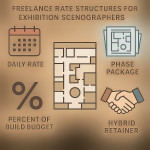Interior architect job market 2025: what studios seek during hiring bursts
Recruiters plan frantic hiring waves as renovation, workplace and hospitality projects rebound in 2025. This guide decodes exactly what design studios now demand from interior architects, so you can align skills and portfolios before the next vacancy appears in your feed.
Why the interior architect job market 2025 is heating up

The global fit-out market is projected to reach $291 billion by Q4 2025, fuelled by adaptive-reuse incentives, ESG regulations and hybrid-office retrofits. Studios scale teams fast when a landmark brief drops. Understanding their selection checklist lets you jump straight to interview shortlists rather than disappearing in a stack of CVs.
Three drivers behind the 2025 hiring rush
- Government tax breaks for low-carbon refurbishments accelerate tender approvals.
- Hospitality bounce-back: hotel groups racing to refresh guest experience before global sports events.
- Corporate lease renewals that demand flexible, brand-centric workspaces without full relocations.
The six top skills studios prioritise
Job ads no longer focus solely on creative flair. Studios list clear operational abilities that keep timelines tight and margins healthy.
1. Deep sustainability literacy
Studios expect you to specify cradle-to-cradle finishes, run carbon calculators and document material provenance. Refresh specs using our sustainable material guide for interior architects to prove you can hit net-zero targets without inflating budgets.
2. BIM coordination that saves hours, not minutes
Firms migrate to cloud-based Revit and Archicad workflows to collaborate with MEP engineers in real time. Demonstrate clash-detection routines and naming standards. Compressed IFC exports—explained in this portfolio compression tutorial—get you bonus points.
3. AR/VR walkthrough mastery
Clients demand instant immersion before signing off. Studios shortlist candidates who build real-time walkthroughs in Enscape or Unreal. If you need a refresher, dive into AR walkthroughs that sell.
4. Adaptive-reuse expertise
Cities give tax credits to transform vacant retail into mixed-use hubs. Show feasibility studies comparing demolition versus reuse, highlighting embodied carbon savings.
5. Inclusive spatial design
Accessibility is now baseline, not a plus. Bring audits covering neurodiversity and sensory-friendly cues. The inclusive design checklist offers ready-to-use templates.
6. Risk and insurance fluency
Worldwide freelancing grows, yet many candidates gloss over liability clauses. Studios favour architects who can outline coverage tiers—read liability insurance basics to avoid red-flag questions during negotiations.
Portfolio elements that win hiring bursts
- One hero image per project with quantified outcomes (e.g., “32 % energy-use reduction”).
- Process snapshots: zoning diagrams, finish schedules and FF&E boards show strategic thinking.
- Interactive content—embed a 20-second AR capture or 360° panorama that loads in under 3 seconds.
- Clarity on your role: bullet whether you led concept, documentation or site coordination.
Publish your portfolio on fast CDN hosting; Google's Core Web Vitals now influence B2B discovery. Many studios scout straight on spatial designer collaboration boards, so a slow gallery equals missed callbacks.
Application hacks for the interior architect job market 2025
Time the surge
Most studios post in two waves: January–March and August–October, aligned with developer funding rounds. Prepare application packets a month earlier to benefit from pre-screening phases.
Tailor micro-case studies
Replace generic cover letters with a 150-word “What I'd tackle first” note referencing the studio's latest project. This positions you as proactive, not reactive.
Prep rapid-fire tasks
Firms often test skills in 48-hour sprints: a restaurant layout, an acoustic ceiling detail, a cost-saving finish swap. Set up template files—layers, dimension styles, title blocks—to shave hours.
Negotiate smart perks
- Ask for software budgets to access new plug-ins that elevate team output.
- Secure learning stipends for external certifications (WELL AP, LEED BD+C).
- Push for flexible site-visit travel to maintain work-life balance during bursts.
Common pitfalls that block callbacks
| Mistake | Why it's a deal-breaker | Quick fix |
|---|---|---|
| Uploading 100 MB PDFs | ATS filters reject heavy files | Compress to ≤10 MB; host extras online |
| Overusing jargon | Non-architect HR can't score your skills | Use plain metrics and visuals |
| No code compliance notes | Studios face legal risk | Add local and international standards references |
| Ignoring budget constraints | Signals creative ego over practicality | Show value engineering wins |
Interactive check: are you hiring-burst ready?
FAQ
- How often should I update my interior architect portfolio in 2025?
- Refresh every quarter so recruiters see recent metrics, certifications and project photography aligned with current regulations.
- Is a master's degree still mandatory?
- Studios weigh experience and specialist certificates—WELL AP, LEED—over additional degrees, especially during rapid hiring bursts.
- What salary growth can I expect next year?
- Global averages show a 6 – 9 % rise for mid-level interior architects, with sustainability leads commanding up to 15 % premiums.
- Do I need professional liability insurance as an employee?
- While firms carry blanket coverage, personal policies can protect side projects and remote consultancy; many recruiters view them as proactive risk management.
Take action now
Audit your CV today, inject the six highlighted skills and trim your portfolio load time. This 90-minute sprint positions you to catch the next vacancy before competing applicants even hear about it.
Ready to elevate your prospects? Bookmark this guide, update your case studies and schedule a mock interview this week.











